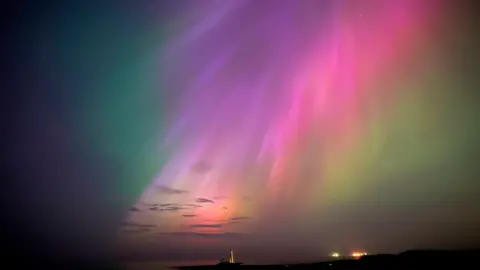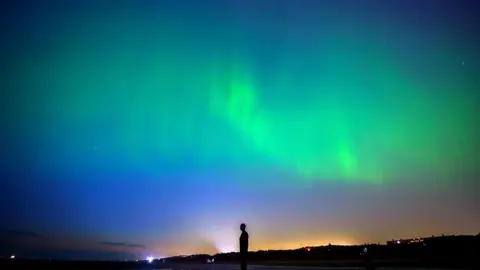Northern Lights in dazzling display across the UK
The Northern Lights are making a rare appearance across the UK, delighting sky watchers up and down the country.
Excited onlookers shared pictures of the lights, also known as aurora borealis, from areas including Liverpool, Kent, Norfolk and Sussex. There have also been sightings in parts of Scotland.
They became visible after one of the strongest geomagnetic storms for years hit Earth, with the US National Oceanic and Atmospheric Administration (NOAA) issuing a rare solar storm warning.
Such storms increase people’s chances of seeing the lights.
 PA Media
PA Media PA Media
PA MediaStorms of this scale could potentially impact infrastructure, including satellites and the power grid, the NOAA warned.
According to BBC Weather, clear skies – like those on Friday evening – make a sighting possible from most parts of the UK.
People in Northern Ireland, Scotland and northern parts of England usually have a higher likelihood.
BBC Weather presenter Elizabeth Rizzini said: “It’s fantastic conditions, the skies are pretty clear at the moment.
“There could be some low cloud that comes into East Anglia and the south west of England and Lincolnshire coast, but generally skies are pretty clear at the moment.”
She added: “Tonight’s the night but it will probably be visible tomorrow as well.”
Met Office spokesman Stephen Dixon said “conditions could continue on Saturday night, but we still have to work out some details on where exactly that will be”.
In the US, the NOAA said the lights might be seen as far south as Alabama and northern California.
What are the Northern Lights?
The Northern Lights – or aurora borealis – appear as bright, swirling curtains of lights in the night sky and range in colour from green to pink and scarlet.
It is caused by charged particles from the sun hitting gases in the Earth’s atmosphere.
The colours occur due to different gases in the Earth’s atmosphere being energised by the charged particles.
The two most common gases in the Earth’s atmosphere are nitrogen and oxygen. Oxygen atoms glow green – the colour most often seen in the Northern Lights, while nitrogen atoms emit purple, blue and pink.
The most impressive auroras occur when the Sun emits really large clouds of particles called “coronal mass ejections”.
LondonGBDESK//



Comments are closed.